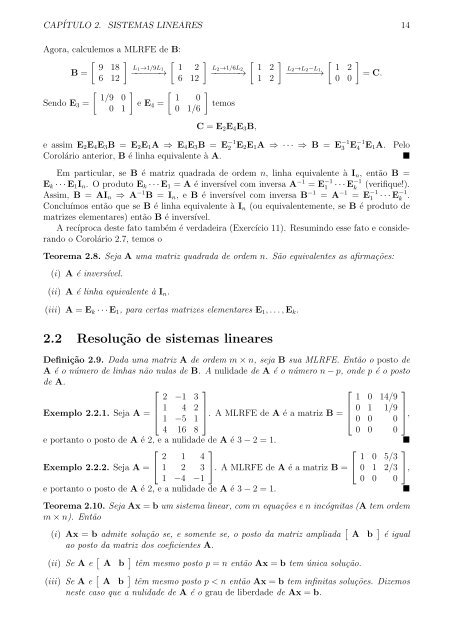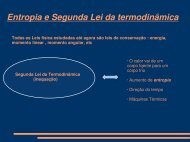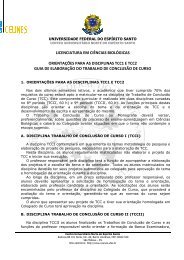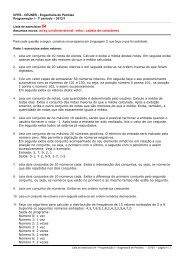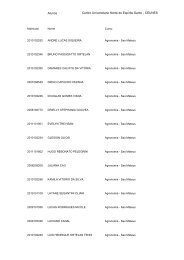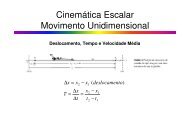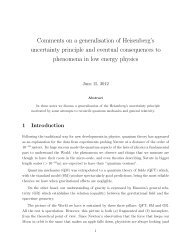ProgramaçËao Linear - Notas de aula - CEUNES
ProgramaçËao Linear - Notas de aula - CEUNES
ProgramaçËao Linear - Notas de aula - CEUNES
You also want an ePaper? Increase the reach of your titles
YUMPU automatically turns print PDFs into web optimized ePapers that Google loves.
CAPÍTULO 2. SISTEMAS LINEARES 14Agora, calculemos a MLRFE <strong>de</strong> B:[ ] [ ] [ 9 18 L 1 →1/9L 1 1 2 L 2 →1/6L 2 1 2B = −−−−−−→ −−−−−−→6 126 121 2[ ] [ ]1/9 01 0Sendo E 3 =e E0 1 4 =temos0 1/6C = E 2 E 4 E 3 B,][L 2 →L 2 −L−−−−−−→1 1 20 0]= C.e assim E 2 E 4 E 3 B = E 2 E 1 A ⇒ E 4 E 3 B = E −12 E 2 E 1 A ⇒ · · · ⇒ B = E −13 E −14 E 1 A. PeloCorolário anterior, B é linha equivalente à A.Em particular, se B é matriz quadrada <strong>de</strong> or<strong>de</strong>m n, linha equivalente à I n , então B =E k · · · E 1 I n . O produto E k · · · E 1 = A é inversível com inversa A −1 = E −11 · · · E −1k(verifique!).Assim, B = AI n ⇒ A −1 B = I n , e B é inversível com inversa B −1 = A −1 = E −11 · · · E −1k .Concluímos então que se B é linha equivalente à I n (ou equivalentemente, se B é produto <strong>de</strong>matrizes elementares) então B é inversível.A recíproca <strong>de</strong>ste fato também é verda<strong>de</strong>ira (Exercício 11). Resumindo esse fato e consi<strong>de</strong>randoo Corolário 2.7, temos oTeorema 2.8. Seja A uma matriz quadrada <strong>de</strong> or<strong>de</strong>m n. São equivalentes as afirmações:(i) A é inversível.(ii) A é linha equivalente à I n .(iii) A = E k · · · E 1 , para certas matrizes elementares E 1 , . . . , E k .2.2 Resolução <strong>de</strong> sistemas linearesDefinição 2.9. Dada uma matriz A <strong>de</strong> or<strong>de</strong>m m × n, seja B sua MLRFE. Então o posto <strong>de</strong>A é o número <strong>de</strong> linhas não nulas <strong>de</strong> B. A nulida<strong>de</strong> <strong>de</strong> A é o número n − p, on<strong>de</strong> p é o posto<strong>de</strong> A.⎡ ⎤⎡⎤2 −1 31 0 14/9Exemplo 2.2.1. Seja A = ⎢ 1 4 2⎥⎣ 1 −5 1 ⎦ . A MLRFE <strong>de</strong> A é a matriz B = ⎢ 0 1 1/9⎥⎣ 0 0 0 ⎦ ,4 16 80 0 0e portanto o posto <strong>de</strong> A é 2, e a nulida<strong>de</strong> <strong>de</strong> A é 3 − 2 = 1.⎡Exemplo 2.2.2. Seja A = ⎣2 1 41 2 31 −4 −1e portanto o posto <strong>de</strong> A é 2, e a nulida<strong>de</strong> <strong>de</strong> A é 3 − 2 = 1.⎤⎦. A MLRFE <strong>de</strong> A é a matriz B = ⎣⎡1 0 5/30 1 2/30 0 0Teorema 2.10. Seja Ax = b um sistema linear, com m equações e n incógnitas (A tem or<strong>de</strong>mm × n). Então(i) Ax = b admite solução se, e somente se, o posto da matriz ampliada [ Aao posto da matriz dos coeficientes A.⎤⎦,b ] é igual(ii) Se A e [ Ab ] têm mesmo posto p = n então Ax = b tem única solução.(iii) Se A e [ A b ] têm mesmo posto p < n então Ax = b tem infinitas soluções. Dizemosneste caso que a nulida<strong>de</strong> <strong>de</strong> A é o grau <strong>de</strong> liberda<strong>de</strong> <strong>de</strong> Ax = b.


